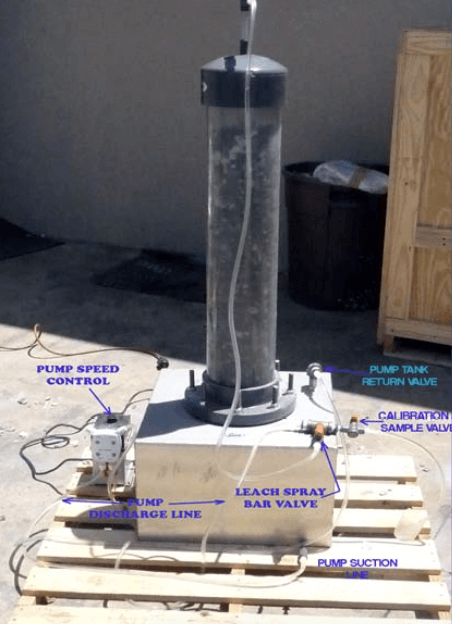1) For better Column Leaching, Agglomerate ore if required. The procedure is to cure for recommended time period. During this time the ore should be kept damp via a wet cloth spread over it.

2) Load ore into the column. This should be done with the column on an angle, and the ore poured gently in to prevent packing. The nylon mesh filter should be placed in position prior to filling the column.,
3) The column should be placed in position and cyanide solution made to concentration (usually 0.1% – ie. 1 gm/litre). Allow for 1 container (5 litres) of cyanide per day (plenty). The flow-rate from the top should be carefully adjusted to give a constant drip approximately 2 ml/min. Slightly more is acceptable. Periodic checks should be made to ensure an even flow rate, and also to check if percolation through the bed into the container below has actually occurred. This percolation time should be noted.
4) After 24 hours, and every 24 hours thereafter, the following procedure should be followed:
i. The pH of the solution (underflow) should be taken. Appropriate adjustments should be made with line (Ca(OH)2) additions to the cyanide solution.
ii. The feed flow rate can be measured by the volume loss incurred in the feed cyanide bottle. This should be reported as volume flow over an hourly period, say. The percolation flow rate can be measured by collecting an underflow sample over a 2 or 3 hourly period (around the 24 hour mark). This should also be reported as volume flow/hour or 1. In some circumstances this underflow may appear too erratic for the 2 hour period. In this case, the volume flow over the past 24 hours would be more accurate.
5) When the test has been run for the appropriate number of days the bed should be flooded with hot water and left to percolate through. The ore can be removed and spread upon sheet plastic to dry.
6) Once a day, the sample should be riffled down to several kg size, crushed and riffled down further to produce a sample for assay.
7) The pregnant cyanide solutions should also be sent for assay.
Note: Take a final cyanide sample to determine residual cyanide by titration.
